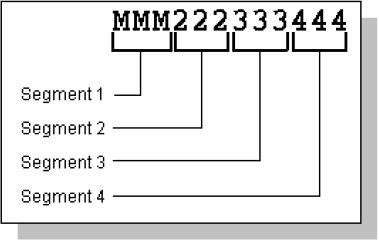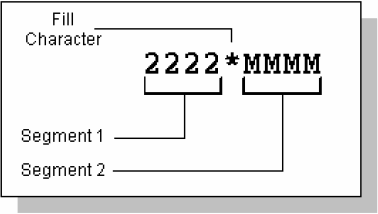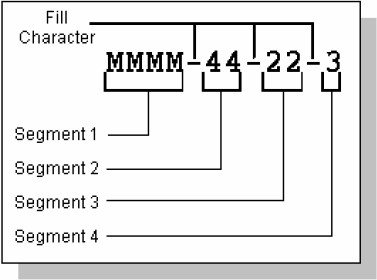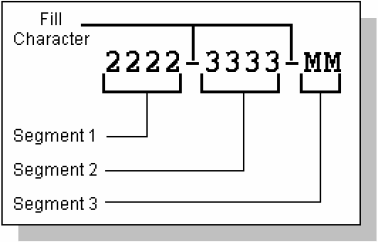TRAVERSE Global v11.1
Defining Account Numbers
A GL account number can consist of 40 alphanumeric characters, and all account numbers must be the same length. You can group the characters into seven segments, which you can separate with one of several fill characters.
Use the following items to set up your account numbers:
The format of an account number is defined by an Account Mask. A mask specifies the number and type of characters in each segment and the fill character that might separate segments. Use the Account Mask function to define an account mask, the number of segments in an account number, and fill characters.
These are some examples of account masks:




Account numbers can consist of any combination of alphanumeric characters, but the account numbers must conform to the account mask. To ensure that the accounts are organized correctly in reports and statements, all the account numbers must be the same length. The system forces all account numbers to conform to the mask.
Account Segments simplify financial reporting and statement setup. For example, you can use segments to show information in financial statements for whatever the segments represent - individual divisions, departments, or subaccounts. You can produce a financial statement for one division or a side-by-side statement for two or more divisions.
Use the Account Segments function to define account segments. When you define an account segment, you specify its value along with a description.
Use Segment 1 numbers to indicate significant groups - assets, liabilities, equity, revenues, and expenses, For example, Segment 1 numbers 1000-1999 could be assets, 2000-2999 could be liabilities, and so on.
If you set up subsidiary segments in the account mask, you can set up a description of each segment you use. The segment abbreviation is the name the segment is given on screens and in reports.
For example, if you use Segment 2 as 001, 002, and 003, you might enter these descriptions:
| Segment | Description |
| 001 | Minneapolis |
| 002 | California |
| 003 |
Texas |
Likewise, if you use departments 10, 20, 30, and 40, you might enter these descriptions:
| Segment | Description |
| 10 | Accounting |
| 20 | Administration |
| 30 |
Sales and Marketing |
| 40 | Shipping and Receiving |
For several General Ledger reports you can select ranges of segments, and you can specify the order of the account segments. The descriptions you assign in the report headers.
An Account Class is the general category an account fits into - for example, long-term asset, current asset, or long-term liability. TRAVERSE has several predefined classes that you can use.
Use the Account Classes function to view account classes and change account class descriptions.
Account Types are predefined by TRAVERSE and contain more detailed information than account classes - for example, an account class of current assets might have account types Cash on Hand, Cash in Bank, and Accounts Receivable. Account types are used to group accounts together to produce statements such as cash flow and trail balance. Each account type has an account class and account code associated with it.
Use the Account Types function to view account types and change account type descriptions.
IDs and codes tell the system how to identify each item on file. The system uses these identifiers to organize information.
When you assigned IDs and codes. establish a format that makes sense for your business and use it consistently. The following suggestions may help you to establish a useful format:
- Do not use these characters in an ID or a code: | : ; & # @
- To prevent organization problems, use zeros to make all IDs the same length. If IDs are divided into more than one part, the parts should be the same length in every ID. Do not use spaces to divide IDs into more than one part. For example, use ACE-01 and ACE-11 instead of ACE-1 and ACE-11 or ACE 01 and ACE 11.
- If you use letters in IDs, use either all uppercase or all lowercase letters so that the IDs can be sorted correctly.
- Use descriptive IDs. For example, WIN001 and WIN002 are more descriptive than 000001 and 000002.
- If you want to sort items by a particular attribute - name or group - put the attribute in the ID. For example, to organize vendors by name, put the first characters of the vendor name in the vendor ID.
- To ensure that new items can be inserted into a sequence, use a combination of letters and numbers that leaves room in the sequence for later additions. For example, WIN001 and WIN005 leave room for three IDs in between.
